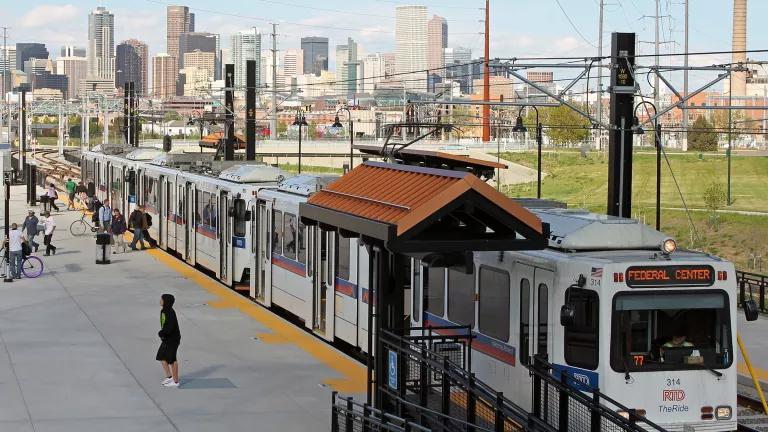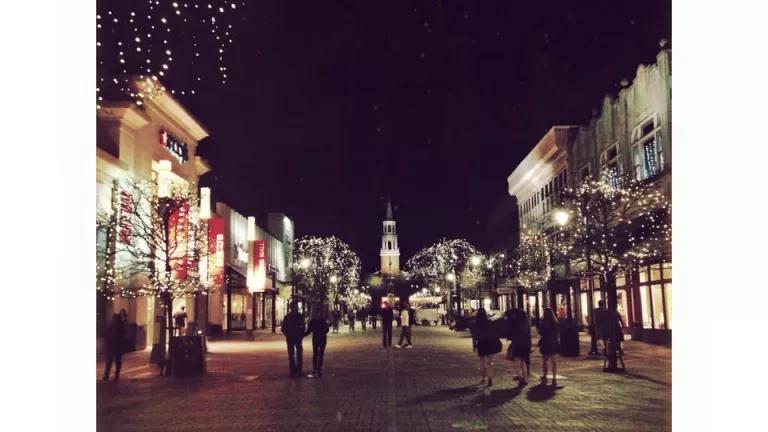
What comes to mind when you think of Vermont? Beautiful landscapes? Maple syrup, craft beer or Ben and Jerry's, perhaps? On my first visit to the Green Mountain State, I was excited to experience all of these. But the main reason for my trip was to explore a vibrant and bustling urban space that I had studied and written about, but never actually seen: Burlington.
The city is known for its diverse, progressive and environmentally-minded demographic. As a student, I studied Burlington's sustainability efforts, examining the city's attempt to weave the "four Es"--equity, economics, education and environment--into its innovative sustainability plan, the Burlington Legacy Project. Despite my research, I wasn't prepared for two things--the incredible alignment of Burlington's environmental goals and feats with Urban Solutions' work and four pillars, and the overwhelming feeling of community and contentment exhibited by its people.
Church Street at night, Burlington, VT. Photo by Hannah Robinson.
In the late 1990s, the City of Burlington recognized a number of critical issues that needed to be addressed to preserve the region's natural features and ensure good health for future generations. Affordable housing was lacking, Lake Champlain was suffering due to invasive species and polluted runoff, and rapid population growth was creating transportation issues and congestion.
The city distributed thousands of surveys to its citizens to assess the city's weaknesses, strengths and the community's visions. Focus groups, the city's Neighborhood Planning Assemblies (NPAs) and representatives from local organizations convened to develop a plan that would improve the city's economy, environmental quality, energy, transportation, education and health programs in the city--understanding that such issues are intertwined and need to operate well together to mitigate climate change and improve quality of life, including for future generations.
Burlington' Legacy Project Action Plan was completed in 2000, and a number of supplements to the plan were released in subsequent years. The city had six major goals in mind: 1) to maintain the city as a regional influence, 2) to provide good job opportunities and affordable housing, 3) to improve the overall quality of life in all neighborhoods, 4) to increase public participation in decision making, 5) to provide high quality education and 6) to preserve environmental health. The supplements specifically addressed issues of growing diversity in Burlington, creating a broad focus on equity and environmental justice.
The Transportation Plan (2011) and Climate Action Plan (2013) address environmental and air pollution problems spurred primarily by traffic and the inefficient use of energy, space and infrastructure. Completion of design-oriented strategies will help to solve land-use difficulties and create a modern, pedestrian-friendly, mobile city that does not rely solely on automobiles. The innovative planBTV (2013) addresses all sustainability issues in its downtown revitalization conceptualization--stormwater management, green space, complete streets and green infrastructure, which also appears as a "cure" for many of the overarching sustainability issues, particularly contaminated water sources and air pollution.
NRDC's Urban Solutions program aims to make urban spaces a central part of the solution to disastrous global climate change. With over half of the world's population now residing in cities, and over 60% of greenhouse gas emissions in the United States coming from our buildings and modes of transportation, it is critical that we create change from the ground up, starting in the very communities in which we live and work. Burlington serves as an example of the solution, embodying the four main pillars within Urban Solutions' strategy:
Land Use, Transportation & Neighborhood Revitalization
Urban mobility has significant impacts on the environmental, social and economic well-being of a community; in fact, many urban problems actually stem from inefficient or poorly-developed transportation systems. Furthermore, climate change is exacerbated by greenhouse gas emissions from the transportation sector. In 2013, Burlington was awarded a silver-level denomination by Walk Friendly Communities for its efforts to reduce transportation problems and increase pedestrian safety and mobility, which included a city-wide 25mph speed limit, a change in parking pricing and the implementation of "complete streets" with bike lanes, refuge islands and green infrastructure. In addition to addressing the "single-occupant automobile culture" to improve community strength in the city, Burlington is working hard to revitalize distressed neighborhoods through the establishment of affordable housing and brownfield redevelopment. In 2001, the city remodeled an 1885 transportation center into a mixed-use development that includes rental units and commercial space. As part of its waterfront revitalization project, Burlington is currently remodeling the Moran Plant, previously a coal-fired power plant, into a net-zero cultural art and community center.

Moran Plant, Burlington, VT. Photo by Hannah Robinson.Stormwater and Urban Resilience
Thanks to climate change, increasingly frequent rain events mean that urban flooding, combined sewer overflows and contaminated stormwater runoff are becoming some of the most pressing challenges facing cities. Green infrastructure provides cities with the opportunity to balance the interaction of the natural and built environments by improving natural filtration and maintaining a financially and environmentally sustainable stormwater management system. To mitigate nutrient loading and contamination in Lake Champlain, Burlington is revitalizing the waterfront and installing rain gardens and bioswales. As part of planBTV, the city has outlined a number of potential designs to be incorporated into Burlington's infrastructure in the coming years, including green roofs, stairway cascades and green streets. The University of Vermont's Aiken Center, which houses the Rubenstein School of Environment and Natural Resources, is certified LEED Platinum and features a green roof that captures up to 50% of runoff and a natural treatment system that recycles the building's wastewater.
Energy Efficiency & Clean Energy Generation
The buildings we work and live in contribute significantly to the carbon emitted from our cities. Increasing the efficiency of buildings, improving demand-side energy use and investing in renewable energies are all solutions that will reduce our dependence on fossil fuels while decreasing the harmful greenhouse gas emissions that contribute to global warming. Burlington has exhibited incredible leadership in this realm, becoming the first city to run on 100% renewable energy from a variety of sources, including hydropower, solar, wind and biomass. UVM's LEED Platinum Aiken Center utilizes high-performance windows and insulation to reduce energy consumption, and over half of the building's electricity needs are supplied by photovoltaic solar panels.
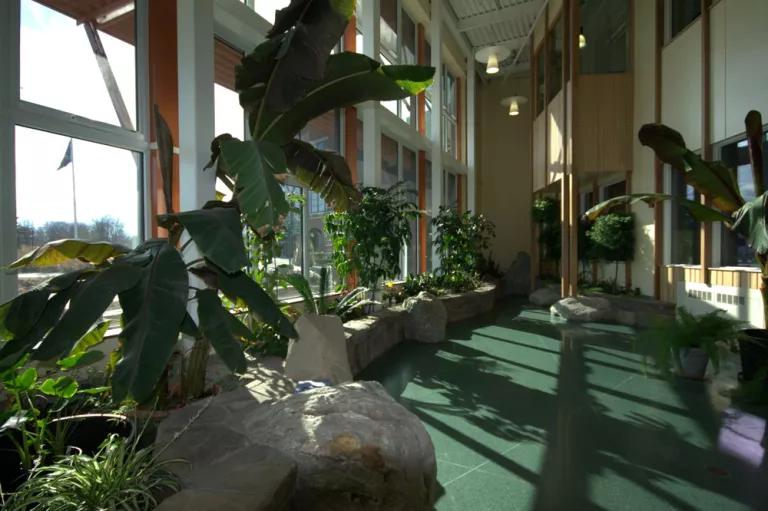
Solarium in UVM's Aiken Center. Photo courtesy of UVM.
Food Equity & Efficiency
Access to healthy and sustainable food choices in our cities is critical. Not only do we lessen our impact on the environment by selecting locally-sourced options, but we can also encourage neighborhood-scale collaboration and improve community health with the use of urban gardens and other sustainable food strategies. In 1993, members of the Burlington community established the Intervale Community Farm to provide affordable, high-quality organic produce to the surrounding region. Not only does the 350-acre farm offer healthy, sustainable food choices to households, but it also allows community members to come together in a cooperative and educational environment. Burlington residents will also contribute to the reduction of landfill waste as the state of Vermont phases in a mandatory composting law (Act 148).
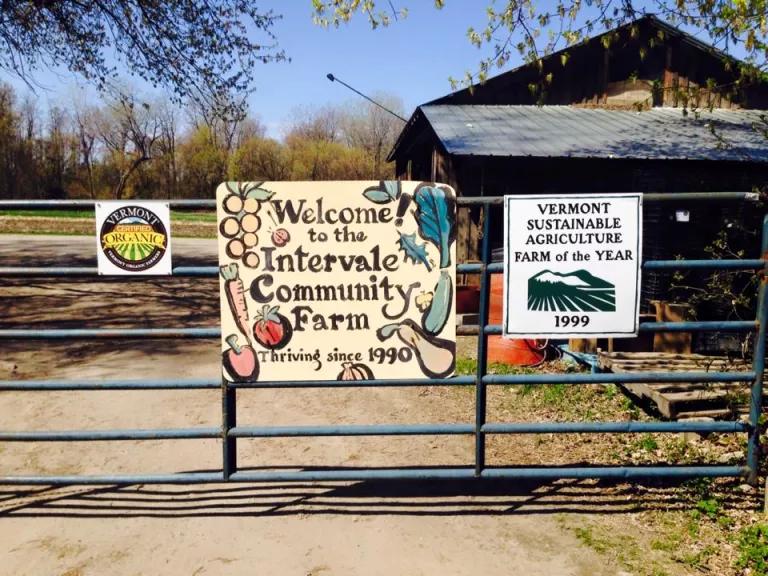
Intervale Community Farm, Burlington, VT. Photo by Hannah Robinson.
It is clear that cities don't have to be large to be influential leaders in the movement towards creating sustainable, equitable and resilient urban spaces. Seeing first-hand what's happening in Burlington--the vision embodied in its comprehensive sustainability plan, the progress that's been made, and the central role people are playing in this inspiring mission--reminded me why Urban Solutions' strategy is so critical to mitigating climate change. The culmination of community-level projects can make a huge difference on a national or even global scale, as evidenced last month when Burlington was designated as a Regional Center of Expertise (RCE) on sustainable development by the United Nations.
By the way, the ice cream and beer are pretty good too--not to mention produced sustainably!
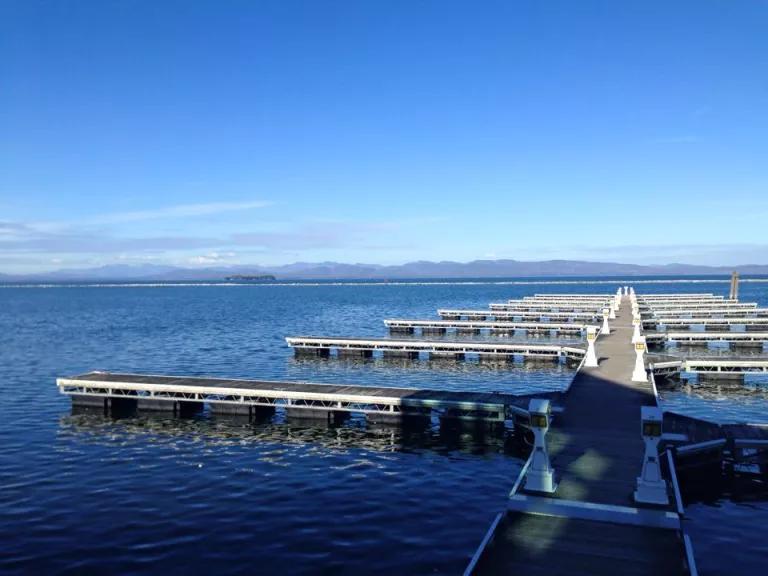
Lake Champlain, Burlington, VT. Photo by Hannah Robinson.


